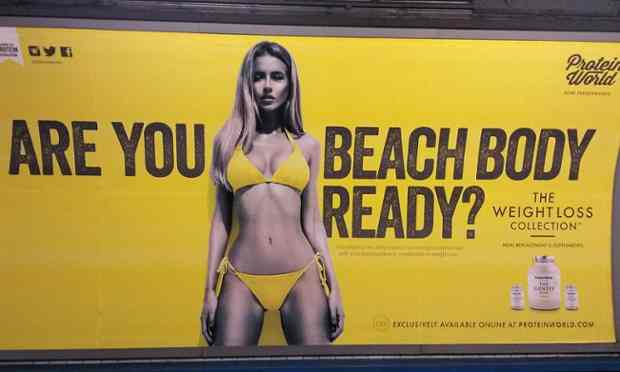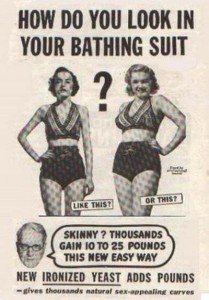This blog post is dedicated to female body image stereotype and how it reflects in advertising. The given examples will represent what kind of females bodies were believed to be ‘beautiful’ back in 1940s and how female body image stereotype has rapidly changed in less than one hundred years.
To begin with, advertising is a form of communication intended to persuade an audience to buy products, ideals or services. While advertising can be seen as necessary for economic growth, it is not without social costs (Dan Padgett, 1997). Not unexpectedly, advertisements dictate how individuals should behave, what kind of lifestyle they should choose and, most importantly, adverts illustrate how people should look like. According to study, conducted by Hovard Lavine (1999), women exposed to sexist adverts judged their current body sizes as larger and revealed a larger discrepancy between their actual and ideal body sizes (preferring a thinner body).
Image one (45775830-2510-465f-a8cb-bda9b5a82951-620×372.jpeg)
The advertisement I would like to talk about has caused a lot of discussions and debates. It is a print advert for Protein World – food supplements that fight with extra weight. In the center of the image there is a model wearing a bright yellow bikini. The girl has a quite skinny body and the advertisement reads ‘Are you beach body ready?’ Target audience is women of all ages who are not confident with their bodies. The advertisement makes an average woman question herself ‘Do I look like the girl in the picture? This kind of advertising creates new apotheosis and is a causer of major psychological issues in women minds. It is the main reason why this controversial ad campaign has received more than 360 complains and has been banned due to the concerns over weight loss claims (Mark Sweney, 2016).
Image two (tumblr_m5o4udatpi1ru3pbjo1_400.jpg)

However, in older adverts the woman body image stereotype motives are completely different. If we take a look at example two – ironized yeasts advertisement published in early 1940s, we see two women (they have different body sizes) and the question mark between them. The caption says ‘How do you look in your bathing suit’ letting viewers (female gender in particular) to pick which body image is more comparable to their bodies. Beneath them there is a head of a man (assumable he is a medic; his glasses suggest it), which says ‘Skinny? Thousands gain 10 to 25 pounds this new easy way’. This advert glorifies curvy body forms and claims that ‘sex-appealing’ curves are beauty standard.
To sum up, this blog post revealed two different sides of female body image ideology. Nowadays advertising industry pushes the idea that beautiful woman is skinny woman. It is a huge issue and this stereotype is the main causer of low-esteem of female gender. On the other hand, more than seventy years ago woman with curvy body shape was considered as beauty standard. This idea humiliated skinny females and lowered their self-esteem too. Neither of these statements is correct; there is no definition of ‘beauty’ and there is no answer which body type is supposed to be ‘beautiful’.
Bibliography:
Lavine, H., Sweeney, D., & Wagner, S. H. (1999). Depicting women as sex objects in television advertising: Effects on body dissatisfaction. Personality and Social Psychology Bulletin, 25(8), 1049-1058.
Padgett, D., & Allen, D. (1997). Communicating experiences: A narrative approach to creating service brand image. Journal of advertising, 26(4), 49-62.
Sweney, M., (2016) “‘Beach Body Ready’ Ad Banned From Returning To Tube, Watchdog Rules”. the Guardian. N.p., 2015.